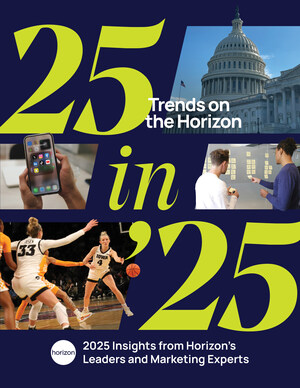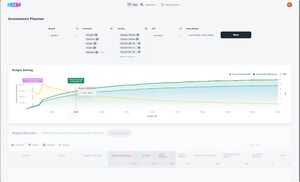- Survey finds that people are largely aware and invested in the entertainment industry strike and are prepared to wait it out by adjusting their entertainment content selections –
NEW YORK, Aug. 2, 2023 /PRNewswire/ -- As thousands of members of the Writer's Guild of America and the Screen Actors Guild continue to strike, Horizon Media, the largest U.S. media agency according to Ad Age Data Center 2023, released findings of a new study called "The Tipping Point," which sheds light on the strike from the audiences' ' point of view. In the 72 hours following the announcement of the WGA strike, there were nearly 800k social posts, and in the same period following the SAG strike announcement, there were 1.1 million related social posts. Although the conversations have slightly subsided since the initial spikes, the Tipping Point results reveal a sustained volume of high interest due to overall awareness and investment in the outcome. Horizon Media's WHY Group surveyed 600 adults 18+ and analyzed social conversation to better understand people's awareness of and reactions to the strikes.
More than half of those surveyed were aware of the WGA strike (52%) and SAG strike (58%) – 11+ points higher than other high-profile labor disputes. However, most notably, respondents are not only aware, but they're invested – with nearly three in four (73%) saying they care and are following the story.
With increasing awareness of and tension around wage gaps in our current cultural climate, it's perhaps not surprising to find people largely on the side of the striking writers (45%) and actors (39%), whom they may find more relatable than the studios (9%), networks (8%) or streaming services (9%). The Tipping Point social analysis revealed that the raised fist emoji—which has historically been used as a symbol of solidarity for marginalized and oppressed groups—has been used more than 53K times to express support for the writers and actors who are on strike. It is also the most used emoji overall by people online to show support for the striking workers.
In addition, the pressure to quickly resolve the disputes by the fall – when demand for new episodes of scripted programs typically increases – may not be as urgent as some may expect this year. When asked what they would do if their favorite scripted shows were unavailable for an extended period, most people are making alternate content choices as they wait for the strikes to resolve and say they will re-watch old shows (47%); find shows/movies on other streaming platforms they subscribe to (35%); spend more time on other non-entertainment hobbies (28%); and try new genres of entertainment (25%).
Only 15% of respondents overall said they'd cancel a streaming service. However, the survey found noteworthy distinctions among different age demographics. Those 35-49 indicate more willingness to subscribe to a new platform to get access to new-to-them content (18%), while younger viewers are more likely to pause their subscriptions until new content returns (25%) or spend more time watching content on social media (55%). People 50+ are more likely to do nothing different (24%).
One common point of concern among viewers is the rising costs of streaming subscriptions. When asked if they would be willing to pay more if streaming prices were to go up to meet the demands of striking writers and actors, roughly a quarter of total respondents (28%) said "yes," while that number increases to 38% for those who support the strikers. For younger viewers 18-25 and 26-34, the percentages increase to 46% and 41% respectively. Still, despite these increases – and greater support for striking workers among younger people in general – the numbers do not suggest an overwhelming willingness to pay out of pocket to solve an issue people largely see as the responsibility of the businesses.
Perhaps more illuminating is those who are least likely to pay more and most likely to unsubscribe - viewers 35+. While at least 50% of each age group indicated a likelihood to consider unsubscribing if prices increase, the highest numbers were among those 35-49 (64%) and 50+ (56%), with those same groups being least likely to pay more – at 27% and 18% respectively.
"Unlike past strikes, people are not only invested in the WGA and SAG-AFTRA strikes, the Tipping Point study also reveals that going forward they are willing to alter their viewing habits in a major way," said Maxine Gurevich, SVP, Cultural Intelligence of WHY. "Given these findings, the next few months will be critical in working to find a swift resolution to the strike, as well as ensuring content libraries are smarter and even more accessible."
For the full survey findings and recommendations for brands, visit https://horizoncatalyst.com/WGA-and-SAG-AFTRA-strikes-awareness-and-viewing-behavior
Survey Methodology
This survey was fielded from July 18-19, 2023 with 600 respondents in the US, weighted to be representative of age, ethnicity, region, and income.
Horizon Media
Horizon Media, Inc, the largest U.S. media agency according to Ad Age Data Center 2023, delivers data-driven business outcomes for some of the most innovative and ambitious brands. Founded in 1989, headquartered in New York, and with offices in Los Angeles and Toronto, the company employs 2,400 people and has media investments of more than $8.5 billion. Horizon Media's fundamental belief is that business is personal, which drives its approach to connecting brands with their customers and engaging with its own employees resulting in industry-leading workplace satisfaction levels (Glassdoor). The company is consistently recognized by independent media outlets for its client excellence and has earned several "Best Workplaces" awards reflecting its commitment to DEI and the life and well-being of everyone at Horizon Media.
SOURCE Horizon Media

WANT YOUR COMPANY'S NEWS FEATURED ON PRNEWSWIRE.COM?
Newsrooms &
Influencers
Digital Media
Outlets
Journalists
Opted In






Share this article